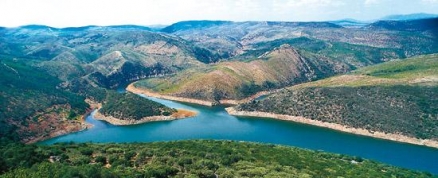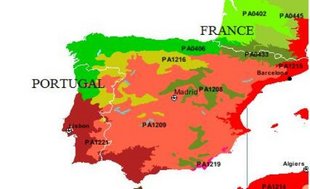Ecoregions of Spain
The ecoregions of Spain consist of an assortment of forest and scrublands, including mixed conifer forests, montane forests and sclerophyllous plant associations.
Ecoregions are areas that: [1] share a large majority of their species and ecological dynamics; [2] share similar environmental conditions; and, [3] interact ecologically in ways that are critical for their long-term persistence. Scientists at the World Wildlife Fund have established a classification system that divides the world in 867 terrestrial ecoregions, 426 freshwater ecoregions and 229 marine ecoregions that reflect the distribution of a broad panoply of fauna and flora across the Earth.
The following ecoregions are found in Spain:
- Cantabrian mixed forests (PA0406) serve as a transition ecotonal zone between the Eurosiberian and the Mediterranean biogeographic regions in Europe, which spreads in a west-east direction along 600 kilometers (km), from the Galician Atlantic coasts (Finisterre Cape) to the Western extreme of the Pyrenees. The ecoregion has warm Atlantic conditions. Average annual temperature is between 8-14 ºC, and average rainfall is between 900 to 1800 millimeters (mm). The coastal strip experiences mild winters and high rainfall, which is very uniformly distributed around the year. The Western Galician-Portuguese coast has a Mediterranean character, being warmer and drier during summer. Higher mountain elevations – mainly the central axis – are characterized by cold winters with abundant snow. The Cantabric and Northern Portugal Mountains still host some old-growth forest, which maintain very pristine conditions and a high biodiversity. About 2,000 vascular plant species, of which between 10 to 20% are endemics are present. Large carnivore populations are still significant. Also of particular interest are the last herds of wild horses. Intensive cattle raising historically has transformed the forests of most of the coastal low elevations and plains into pasture lands.
- Pyrenees conifer and mixed forests (PA0433) are located in the Pyrenees, a mountain system that bridges Central and Mediterranean Europe and contains high levels of biodiversity and many endemic species. The Pyrenees are divided into three major bioclimatic sectors. The western portion is affected by the mild and humid Atlantic air streams, the central continental sector by colder and drier weather, and the eastern section by a Mediterranean influence, which brings warm summer drought. A Mediterranean transitional climate type predominates in the southern Pyrenean lower ranges, known as the "Prepyrenees". About 64 species of mammal inhabit the Pyrenees, including some endemic subspecies. Of the 3500 species of plants found in this ecoregion, about 200 are endemic. Wilderness areas can still be found in certain valleys, canyons, and high slopes of the Pyrenees. Some species of special concern have critically low populations and are susceptible to extirpation in these [[mountain]s]. Intensive logging operations, ski runs, winter tourism resorts, road construction, and power stations/dams threaten the survival of some of the best preserved forest habitat in Western Europe.
- Northwest Iberian montane forests (PA1216) extend from the Mediterranean southern slopes of the Cantabric Mountains to the central Iberian high mountain range. The ecoregion is characterized by low to medium elevations, which occasionally exceed 2,000 m. Climatically, the ecoregion is characterized by mild Mediterraneo-Atlantic conditions (average annual [[temperature]s] between 7-13ºC, average rainfall between 500-1000 millimeters (mm)), with cold winters (average temperature of the coldest month between 0-5º C) and a moderately intense summer drought period. The Northwestern Iberian forests do not host a very rich indigenous flora. The ecoregion has some endemics, but the endemism rate is less that 10% of the total flora. Large carnivores are primarily represented by the wolf (Canis lupus). Large herbivores are generally largely distributed. The ecoregion’s forests have been intensively converted to grassland for use by livestock and for agricultural land. The remaining forests are almost entirely transformed into coppice woodlands, due to intense firewood collection during the last centuries.
- Iberian conifer forests (PA1208) encompass several mountain ranges of Spain. Climatically, the ecoregion is characterized by an average annual rainfall of 1100 millimeters (mm), but in certain high altitudes levels can exceed 1500 mm. Snow falls frequently during winter and minimum average [[temperature]s] are below freezing (-5 to 0ºC). The endemism rate of this ecoregion varies from about 15-20% in the central mountain ranges (Gredos, Guadarrama, Gúdar, Javalambre), to more than 40% in the summits of the southeastern Baetic and Sub-Baetic mountains (Sierra Nevada, Baza, Cazorla). These southeastern mountains are home to more than 3000 vascular plant species, or about half of the flora of Spain, and including about half of the country’s endemic plants. The ecoregion hosts a very high faunal diversity, mainly in regard to birds. More than 150 species have been recorded for certain mountain ranges, including a significant number of endangered large birds. An important number of endemic amphibian and reptile species appear in high mountain lakes, meadows, and rocky areas. Current human impact is still high in this ecoregion. Mountain tourism, ski facilities, and road construction are strongly degrading large mountain forest ecosystems. Due to the soil instability of the steep mountain slopes, road construction, and clear-cutting operations have provoked serious landslides. Other primary threats include forest fires, overly intense and inadequately managed logging operations, and overgrazing and unsustainable plant-collecting.
- Iberian sclerophyllous and semi-deciduous forests (PA1209) cover the central plateaus, valleys, and low plains of the interior portion of the Iberian Peninsula. Climatically, the ecoregion experiences very hot and dry summers and relatively mild and subhumid winters. The northern plateau has a more continental climate, which tends to decrease winter [[temperature]s] considerably. Annual average temperatures range from 8-15 ºC, and the minimum average temperature of the coldest month ranges from 1-5 ºC. Annual rainfall averages range from 300 to 850 millimeters (mm). The forest ecosystems of the region are primarily evergreen broadleaf and conifer canopy species. Generally speaking, the endemism rate (strict endemic species) is below ten percent of the total ecoregional flora. Rivers in the region harbor a unique relict fauna. They also represent an important refuge for certain mammals, such as European otter (Lutra lutra), an important number of [[reptile]s], and wintering bird species. Altogether, the ecoregion boasts more than 220 breeding vertebrates, about twenty percent of which are raptors. Most of the ecoregion has been intensively transformed into agricultural land of extensive wheat crops, vineyards, almond and olive groves, fruit tree orchards, and other irrigated crops. Human impact remains high. Degradation is mainly a result of agricultural intensification and large irrigation plans including extensive greenhouse crops on coastal land, inadequate forestry programs promoted by European Union subsidies, dam construction, road building, andintense hunting practices.
- Northeastern Spain and Southern France Mediterranean forests (PA1215) encompass northeastern Spain and southeastern France. The ecoregion’s coastline is characterized by cliffs, sand dunes, and salt lagoon systems of outstanding biodiversity. Forests are mainly composed of mixed evergreen and deciduous broadleaf and conifer species.Climatically, the ecoregion experiences very hot and dry summers, and relatively temperate and humid to sub-humid winters. Annual average temperature ranges from 10-17ºC, and the minimum average temperature of the coldest month ranges from 5-10º C. The annual precipitation ranges from 350-800 millimeters (mm) and is typified by torrential rainfalls in autumn. The ecoregion includes several centers of plant diversity (Balearic Islands, Catalonian coastal ranges, Alicante Mountains) with an endemism rate between 10-20% of the total vascular plants. Large mammals are not particularly prominent in this ecoregion. Most of the ecoregion has been intensively transformed into agricultural land, including mountain crop terraces and pastures, extensive vineyards, almond and olive groves, fruit trees orchards, and other irrigated crops. Coastal urbanization for tourism development is intensively degrading the last remaining coastal woodlands, as well as provoking an alarming situation regarding water shortage and pollution.
- Southeastern Iberian shrubs and woodlands (PA1219) are located on the southeastern coast of Spain, and are characterized by a warm and dry climate with volcanic rock forming portions of the coast. Climatically, the ecoregion is characterized by very warm (winter average temperature of about 11-12º Celsius) and extremely dry (between 200 and 250 millimeters (mm) of annual rainfall) conditions. Strong dry winds such as the Saharan "siroco" occur frequently, intensifying drought. This ecoregion is distinguished by an almost complete absence of tree species. Many different small shrub communities and grasslands characterize the ecoregion vegetation. The faunal species of this ecoregion are quite unknown. Nevertheless, it seems that only bird species are specifically adapted to the semi-arid steppe character of this ecoregion, resulting in a very rich group of species. Recent land use changes, such as intense greenhouse agriculture and coastal tourism development, have produced significant impact. These are difficult to challenge due to the high economic interests behind them. Greenhousing, house building, and golf courses are threatening important [[habitat]s] and the fragile water balance of the ecoregion (water-bearing salinization).
- Southwest Iberian Mediterranean sclerophyllous and mixed forests (PA1221) are located on the southeast coast of the Iberian Peninsula, and are characterized by a human-made semi-natural landscape, formed by extensive semi-natural sylvopastoral woodlands. Climatically, the ecoregion experiences very hot and dry summers and relatively mild and humid winters. Annual average temperatures range from 13-19 ºC, and the minimum average temperature of the coldest month ranges from 1-10 ºC. The ecoregion is influenced by cold offshore currents, which tend to moderate the temperatures and increase air humidity. Annual rainfall ranges from 450-900 millimeters (mm). The ecoregion’s forests are mainly composed of evergreen broadleaf canopy species. So far, there are no quantified data regarding the endemic vascular plant species of the ecoregion. Undoubtedly, the rate of endemism is very high, as many endemic plants are associated with the ecoregion. The ecoregion also represent an important refuge for certain mammals, such as otter (Lutra lutra), and for an important number of reptiles, as well as wintering and nesting bird species. Major land-use changes induced by governmental policies are responsible for the past and on-going land degradation and habitat fragmentation in the ecoregion. Degradation is mainly a result of agricultural intensification and large irrigation plans including extensive greenhouse crops on coastal land, inadequate forestry programs promoted by European Union subsidies, impact on overexploited sylvopastoral woodlands, coastal tourism and urbanization, dam construction, road building, and poorly managed and overly intense hunting practices.
See also:
Ecoregions of France
Ecoregions of Italy
Further Reading
- Bailey, Robert G. 2002. Ecoregion-Based Design for Sustainability. Springer-Verlag. New York, New York. 240pp., 100 illus. ISBN 0-387-95430-9
- Bailey, Robert G. 1998. Ecoregions: The Ecosystem Geography of the Oceans and the Continents. Springer-Verlag. New York, New York. 192pp., 107 illus., 10 tables. ISBN 0-387-98305-8
- Bailey, Robert G. 1996. Ecosystem Geography. Springer-Verlag. New York, New York. 216pp., 122 illus., 14 tables. ISBN 0-387-94586-5
- Heath, M.F. and M.I. Evans, Editors. 2000. Important Bird Areas in Europe: Priority sites for conservation. Vol 2: Southern Europe. BirdLife International, BirdLife Conservation Series No: 8. ISBN: 0946888361
- Hogan, C.Michael. 2007. 2007. Los Silillos. The Megalithic Portal, ed. A. Burnham
- IUCN. 1996. 1996 IUCN Red List of Threatened Animals. IUCN, Publication Service Unit, Cambridge. ISBN: 2831703352
- Medail, F. and P. Quezel. 1997. Hotspots Analysis for Conservation of Plant Biodiversity in the Mediterranean Basin. Ann. Missouri Gard., 84.
- Omernik, James M., 1995. Ecoregions: A spatial framework for environmental management. In: Biological Assessment and Criteria: Tools for Water Resource Planning and Decision Making. Davis, W.S. and T.P. Simon (eds.) Lewis Publishers, Boca Raton, FL. Pp. 49-62. ISBN: 0873718941.
- World Wildlife Fund, Ecoregions homepage, Accessed 1 May 2009.

